7 min to read
Everyone knows that SEO is an essential step for the success of ecommerce and web-based companies. If you want to increase your online sales, potential customers must be able to easily find you. With over 40,000 Google searches happening every second, it is therefore obvious that the search engine should not be ignored under any circumstances.
With continuous changes to Google’s algorithm, each new update to the search engine adds an additional layer of complexity to reaching your ecommerce SEO objectives. Nevertheless, there are some time-tested SEO techniques that every ecommerce brand should employ for long-term impact.
So, what tools and techniques not to be missed to make a difference?
This Guide Will Show You How To Create a Successful Ecommerce SEO Strategy
1.Leverage Your Google Analytics Data for SEO Insights
Data is the foundation of a successful ecommerce SEO strategy. Google Analytics is the quintessential tool for website optimization.
How?
It provides insightful reports on the behaviors of your visitors across mobile, tablet, and desktop. Once you have this data, you can identify where you are underperforming and optimize accordingly. Learning to master this tool is learning to manage your market.
Acquisition
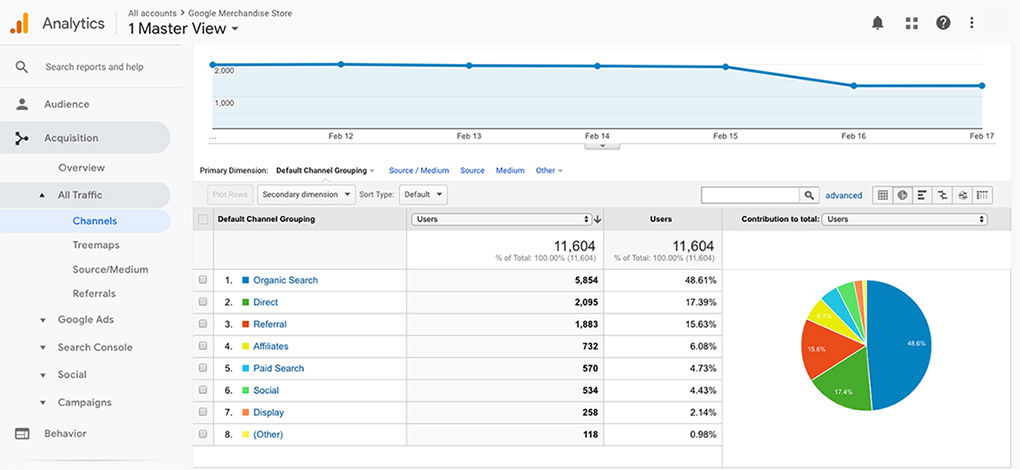
This section allows you to analyze where your traffic is coming from. On the Channel report, you can see a detailed breakdown of the different “pathways” users are taking to get to your website. How many of these users are coming from Organic Search?
Google Search Console
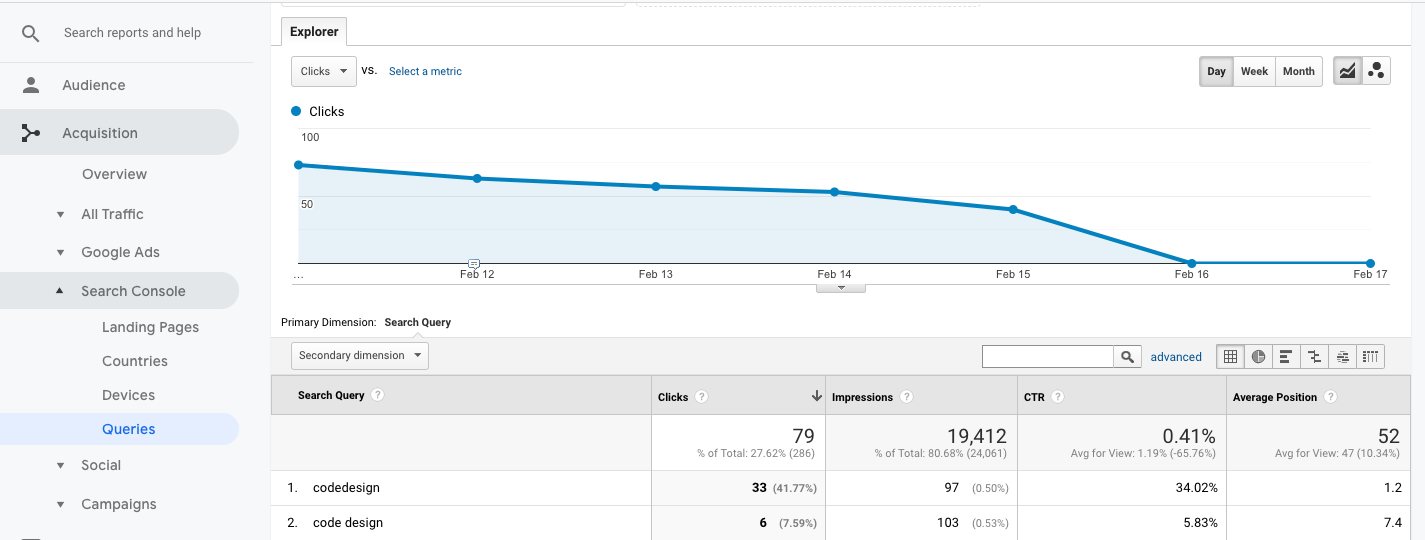
If you haven’t already, connect your Google Analytics account with Google Search Console. The Search Console Queries report provides deep data on search behavior, and how people are finding your website on Google’s search engine.
Unlike the Keyword Planner or other tools which only show you historical or predictive metrics, Search Console shows you the terms people actually searched to find you.
The keyword insights are a goldmine for SEO. Use them to optimize your website’s content.
Behavior
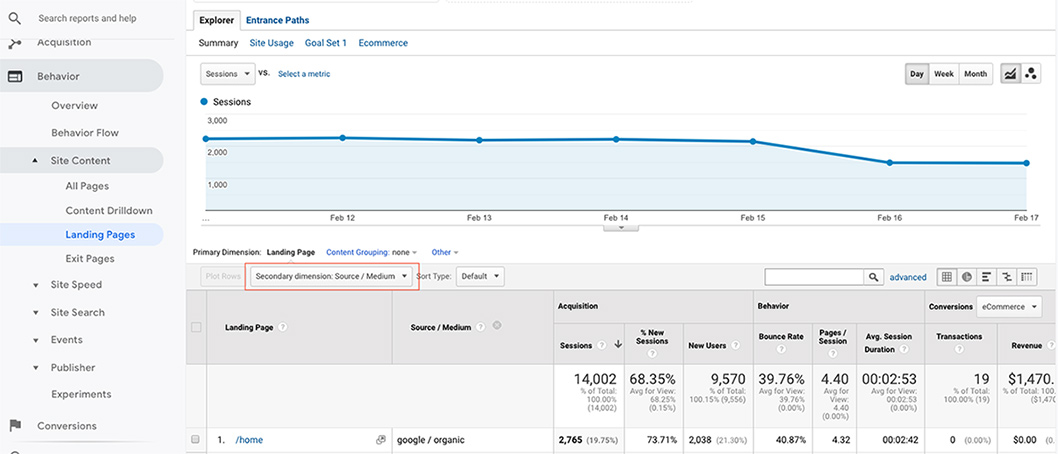
Not all web pages are created equal.
Certain pages on your website will rank higher on search engines than others based on the keywords, traffic volume, content quality, and other ranking factors. It’s important to know which of your pages are responsible for bringing in the most organic traffic, and which pages are not pulling their weight. This will help you identify critical areas to optimize.
In the Behavior section, the Landing Pages report will show you all the pages that users entered your site through. Add “Source/Medium” as a secondary dimension to cross this data with Organic Traffic and see which page content attracts the most users.
Conversions
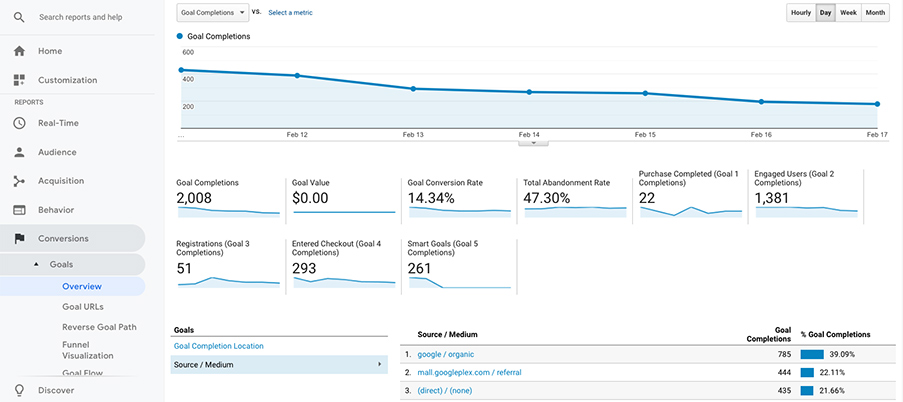
Now you know how much of your website traffic is from Organic, along with which keywords and landing pages are driving those sessions. But how valuable is this traffic for your business?
In the Conversions section, you can break down goal completions by Source/Medium and see how big of a role organic traffic played in your ecommerce sales.
Click on the Google/Organic source to expand the report and learn more about your Organic Traffic shopping behavior.
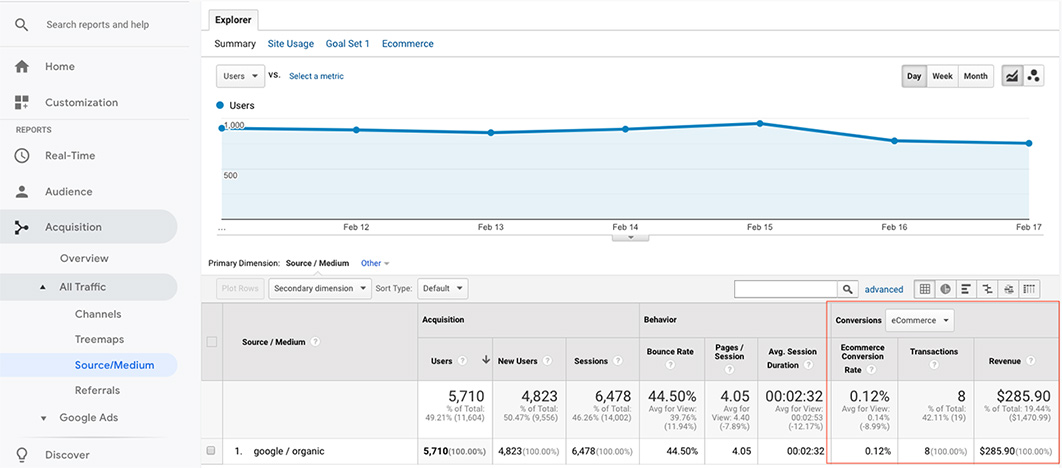
For a more granular view on how your Organic Traffic contributes to conversions, go back to your Landing Pages report and analyze the conversion columns on the right. Cross this with your insights from the Queries report to deduce which keywords and website content are bringing you the biggest return.
Pro Tip: Upgrade to the Enhanced Ecommerce plugin for Google Analytics to get the most granular ecommerce data.
2. Focus on The Product Page
Your website must be designed to anticipate the movements of your visitors. It is necessary to encourage the actions you want them to take on your website- in this case, buying your product.
Creating Trust Signals
A sense of trust must appear throughout your brand universe if you want people to buy from you. Having a trustworthy website also helps improve time on site and other relevant metrics.
Make these trust signals extra visible on the product page. Some examples are:
- Plenty of product images
- Clearly defined shipping process
- Return policy
- Website terms and conditions
- Product Reviews (authentic ones only!)
Real-time customer support also improves consumer trust and reduces bounce rates. Consider adding a live-chat to your ecommerce site.
Optimize Your Product Descriptions
The need for text and structured sentences has been a central SEO ranking factor since the release of the Google Panda algorithm in 2011 and has continued to be critical in all subsequent Google updates.
Make sure you have a unique, informative and easy-to-read product description.
As an ecommerce store, you must also regularly update the product information as often as possible or necessary. And, while you want to keep a uniform structure among your product descriptions, avoid creating duplicated content as this can have a negative impact on SEO.
How to write a product description for ecommerce SEO
- Have a clear and precise title (H1)
- Structure your content with short paragraphs, separate them with subtitles (H2 and H3)
- Add Main product keywords into your meta-tags, including meta-descriptions
- Use bulleted lists, highlighting important details in bold
- Add keyword optimized alt-tags to images
- Clearly indicate the price (and any promotions)
- Display delivery terms with the price without waiting for the purchase pages. Indeed, many visitors will abandon the cart if they don’t receive this information up front.
As an ecommerce store, you must also regularly update the product information as often as possible or necessary. And, while you want to keep a uniform structure among your product descriptions, avoid creating duplicated content as this can have a negative impact on SEO.
Pro Tip for WordPress Users: Yoast Plugin
WordPress is a simple but powerful CMS, which is why many ecommerce brands use WordPress + WooCommerce to build their online store.
If your website is WordPress, make sure you are using the Yoast SEO plugin. Yoast scores the SEO quality of your meta tags and page content, making optimization easy. Just enter your target keyword, and use the optimization bar, which should be green and as large as possible.
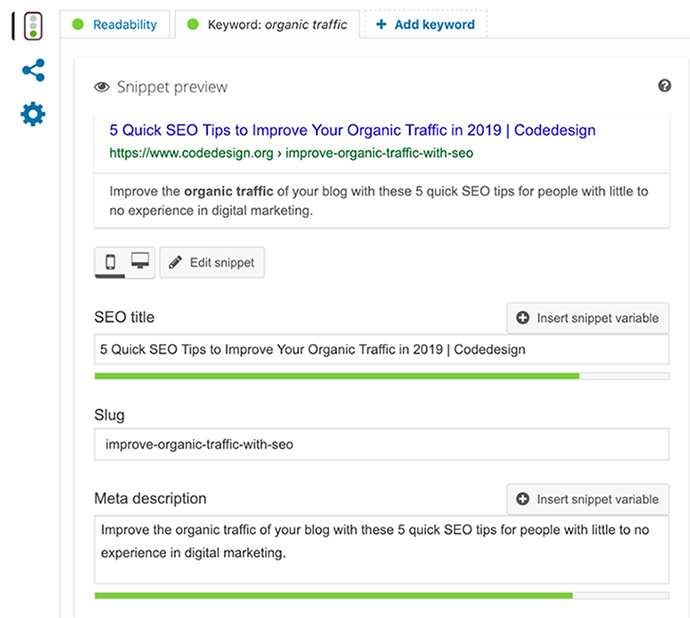
Optimize Your Product Images

The image is a very good way to convey a feeling, tell a story, and sell a product. Optimized images meet the following criteria:
- High-quality (not blurry or pixelated)
- Colorful
- Mobile friendly
- Can be zoomed or enlarged
- Show your product used in real-life context (i.e. a dress being worn by a person as opposed to a dress on a hanger)
- Size is compressed
Having compressed images is critical for maintaining a quick website load time. Not only is website speed an important SEO ranking factor, but you can lose many potential customers during the loading time. You can test your website speed using Google Page Speed Insights.
3.Pair Content Marketing with Social Media to Improve Your Ecommerce Ranking
Blogs are powerful tools for increasing your organic traffic. Sharing your website content on social media can help you increase reach, drive website traffic, and improve your Search Engine rankings.
Create a content marketing strategy that is customer-centric. Here's what you need to keep in mind when writing content for potential customers:
- Who is your ideal customer?
- How old are they?
- What else are they interested in beside your product?
- In which sectors do they work?
- What are their motivations?
- What are their pain points?
When customers are looking to buy a product, they don't want to hear an arrogant sales pitch. So how can you sell your products in a way that creates value for them? If you can show them how your product can be useful to them and meet their needs, they will be more likely to buy your products.
Pro Tip: Use the Free Content Calendar Template from Codedesign to start writing content that converts!
4.Optimize the Ecommerce Checkout Process
So you’ve made it this far.
All of your previous SEO efforts deserve to be successful, don’t lose a potential customer in the final stretch.
The checkout process will create a lasting impression of your brand and will be the final deciding factor if a user will purchase or not. It is, therefore, necessary to be thorough.
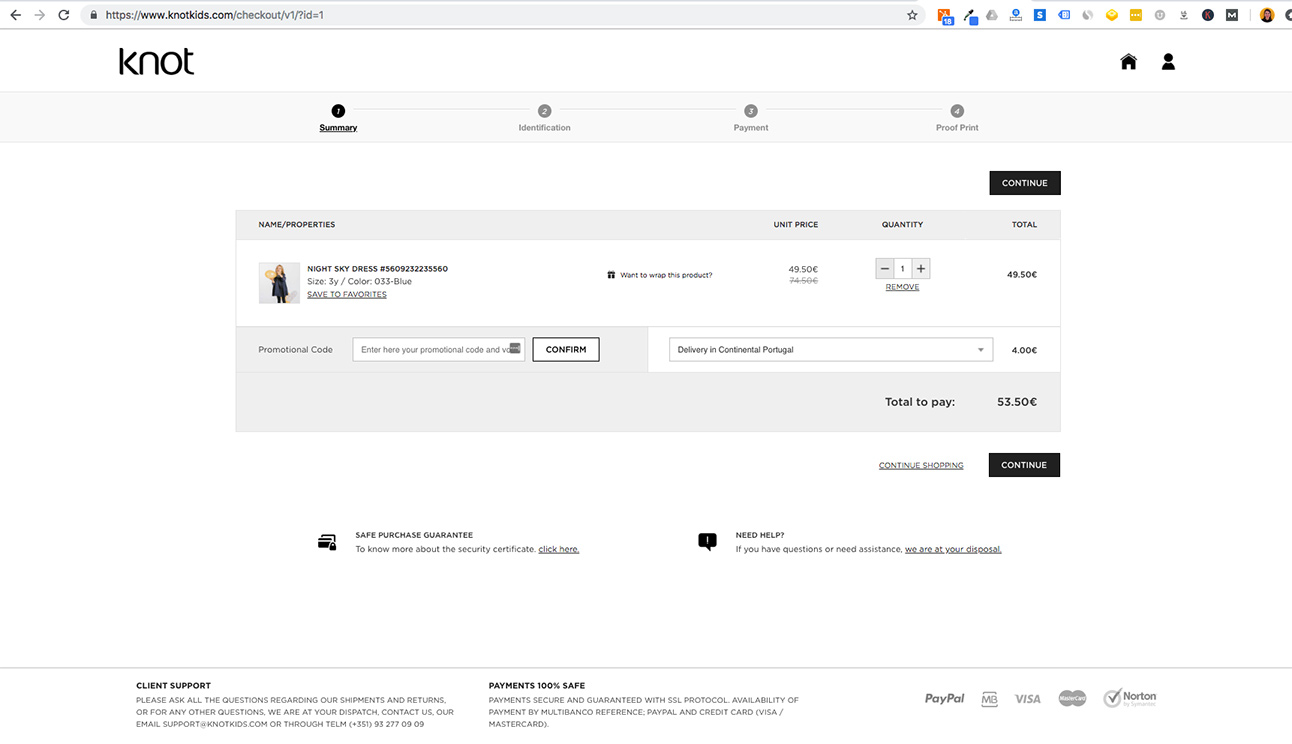
Create an Easy yet Detailed Process
An optimized checkout process includes:
- Checkout progress indicators
- No distracting information
- Minimal exit paths
- Indicate Mandatory or optional field
- Visual alerts when a field is missing/incorrect
- Users can easily see what is in their cart
Avoid user friction
Having a professional design is important for the confidence of your visitors. A professional design is not necessarily about making an artistic site. The important thing is to have a site that is familiar, intuitive, and therefore credible. It must be usable for your visitors so that they can find their way around.
Give the User Freedom
While you want to urge the user to complete the purchase, you want to make them feel empowered in the process. This means:
- Do not force buyers to register before buying.
- Make customer sign in easy and allow them to connect via Facebook, Google, Twitter, etc.
- Include at least 3 different types of payment. It means offering different payment services, Paypal, Google pay, Apple pay, etc.
Encourage Trust
Although ecommerce has become the norm, many people are still hesitant to process payments online. Avoid customer drop-offs by encouraging trust.
Your website needs to have a Secure Connection, which indicates users that it is safe to handle sensitive information, like credit card details. This is the HTTPS (as opposed to HTTP) at the beginning of your website URL. Having a Secure Connection is also a critical factor for SEO. In fact, Google Chrome will often block websites who do not have an HTTPS as they are deemed non secure.

Once again, you also want to make sure reassurance logos are highly visible. These may be credit card logos, payment gateway logos, or third-party security verification logos.
You could also check these local SEO services to boost your online presence.
E-commerce SEO: An Ongoing Process
Congratulations, you optimized your online customer journey and made a sale!
What’s next? Go back to your analytics.
SEO is an ongoing and cyclical process. When it comes to optimizing your ecommerce website, there is always room for growth and improvement. Be sure to always be searching for areas to improve and stay a step ahead of your competition.
Need help implementing an E-commerce SEO strategy? We are recognized as a top E-Commerce Design & Development Company on DesignRush.
Codedesign is a digital marketing agency specializing in data-driven online sales and lead generation solutions for brands in a variety of verticals. Contact us to schedule a consultation with one of our digital marketing experts.



Add comment ×